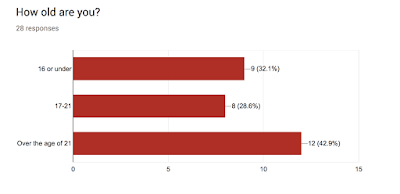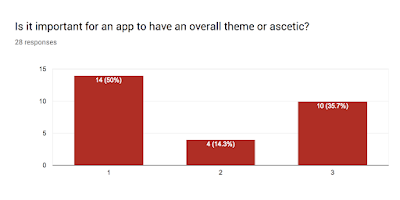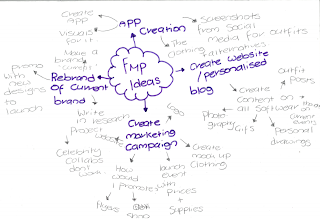To begin my research into 'Snapthat' I created both a survey and focus group to reach bigger audiences in my target audience of 18-25-year-olds, I combined the two as they are of a similar concept that coincided with one another.
As for my survey, I collected 28 completed. I think this is reasonable, however not as many as I possibly could have wanted. Not dwelling on this, I have collected the feedback and can reflect on the data given to me. From those who answered my survey, 13 were female, 13 male and 3 of those chose not to say, this is a strong mix of those who answered so I know I can interpret this data equally. If I was to do this again and go out of my way to do so by approaching those around in our local town or city. The only set back to doing this is that many are hesitant to answer in person as it can be time to consume therefore another way I could reach a bigger age demographic is to share it online through those of a similar to those older such as older siblings or even parents.


Here you can see that of those who answered, 42.9% were over the age of 21. This data suggests that most of those in this age group will be financially responsible and so more likely to online shop (by assumption) meaning that there could be room for my app on the market. This is good to know as it gives me confidence that I can pursue this further if I wanted to, to further prove this theory 53.6% of those who answered said that they would like the idea of this app and want to use it, therefore giving me more great results in knowing that my app could have success if it was to launch it into this market. Looking more in-depth at my target audience, I wanted to know how they felt about the apps first appearances, in other words, I wanted to understand how important the first impression of the app is. Out of the 28 who answered my survey, 15 said that it was 1 (Very) important for an app to look good sat on a home screen of their smart devices, I will take this into account when focusing on my design work, really focusing on 'Snapthat''s app icon and its colour themes to ensure it looks appealing and to be successful. To take this further next time, I would like to focus in on what the on what styles or examples of current apps that those in my target age group like or do not like.

After receiving my feedback how important the appearance of the app is, I wanted to discover if an overall theme of an app is really
that important. As you can see, the majority vote agreed that is important for an app to have an overall theme, this is really important to keep things consistent and I will ensure this through things like font, colour themes and picture and text placement. I should have read through my survey thoroughly, I will admit that I rushed my survey slightly as the opportunity for me to do it in was spontaneous meaning that I had a spelling error, spelling 'Ascetic' instead of 'aesthetic', nobody pointed this out to me so It is clear I am not the only one who can't spell it! Further data from my survey suggested out of those who answered it, more would prefer a text-based app over one that was image based, I do not think I will continue with this information as I want to take my app in an image based style. Thankfully, It wasn't an overwhelming majority that preferred text-based apps and so I know that there will not be a sudden distaste for it. One of the final questions asked in my survey was 'which artistic style do you prefer?' As you can see, most of those who voted wanted more illustration based styles of images than other options suggested such as block colours. I am glad that those who voted wanted more illustration based images as these are some of my favourites to create, knowing this I know that I can put time and effort into my artwork to make it relevant to 'Snapthat'.

Overall, I am really happy with the feedback I received from my survey to push myself into my next steps of experimentation. A few minor issues such as not getting as many participants as I would have liked really disappointed me and due to not having more time to collect more answers even through sharing on social media, I feel like I could have pushed it further through outlets such as more social media. Another issue I faced with the typo which I spoke about above, it was a minor error which I couldn't change but thankfully I discovered this typo before it was too late. In the future, I would wish to add more questions into the questionnaire to make it more thorough, if people have the time to be answering my questionnaire it should be used efficiently ensuring that as many questions as possible are answered so I can relate back to what they want. I will be sure to incorporate this into my next survey during the production process, I would also do my survey in a less social setting than done with this one to ensure I had the focus of my participants but I am relieved to have the filled out surveys I do and these will carry with me until the end of my FMP.
As for my focus group, I asked a collection of 18-25-year-olds, 15 of them said that they would complete my focus group which was great to gather a large amount of information together about my target audience. Unfortunately, due to the social setting in which the focus group was completed; I couldn't record the information that was fed back to me as it would be incoherent anyway. To combat this I ensured to write down key notes that would be useful for further research, writing down the information I also stated their gender and age as these are both important factors to take into account for when using the data later. I believe that a focus group is beneficial to me as it can really help me have a deeper understanding of what my target audience is attracted too in terms of app usage and overall theming and ascetic. As for the questionnaire itself, I wanted to keep the number of questions to a number lower than 10 as I didn't want the participants to get bored, In doing this I also limited the focus group discussion to being less than half an hour for the same reason. As for the questions I brought up to the group, I wanted to establish a clear understanding of what I meant by each one instead of derailing the discussion by asking what the question meant instead of answering it. Here are the questions I asked;


During this process, I wanted to remain consistent throughout the focus group and remain neutral through the q&a process. On top of this, I wanted to balance dominant participants with those more introverted, encouraging answers from those who may shy away from speaking such as 'What do you think about this?' in doing this I ensured that all of the participants had a chance to speak. The feedback I received has been a great help, I will be using this feedback to further my research and influence my app designing. Here you can see the notes I took during the focus group; As you can see, informal notes have been written throughout the focus group as well as gender and age to note down a difference in opinion from the differentiating sectors.

To make my information for formal, I created an infographic, in doing this my results can be seen more visually than just writing on paper; Here you can visually see the information taken from my brief notes and solidified it into a visual display to make the information more readable.
Overall, I found the varied responses depending on the factor of age or gender very interesting to look at such as the male participants of the focus group were less open to the concept of the app than women but I didn't think too much into it. Another interesting fact I picked up on was the fact that those in younger age categories such as 19, wanted more advertising for the app to come in the form of merchandise, a suggestion of this would be that due to the age group they lie within, they could possibly be a student or only in part-time work suggesting that they may not earn that much money and so want the free things as a bargain, this something that I would now like to look into and design as a potential marketing tactic. If I was to go back and do this focus group again or another focus group in the future I would like to push for more in-depth answers and really question why those who thought the way they did, did. I would like to understand the physiological reading behind why those in their separating categories as participants wanted things like merchanding for the app. I am happy with the feedback given to me as some of the points made are genuinely helpful such as screen compatibility to consider when making the mock app.






















